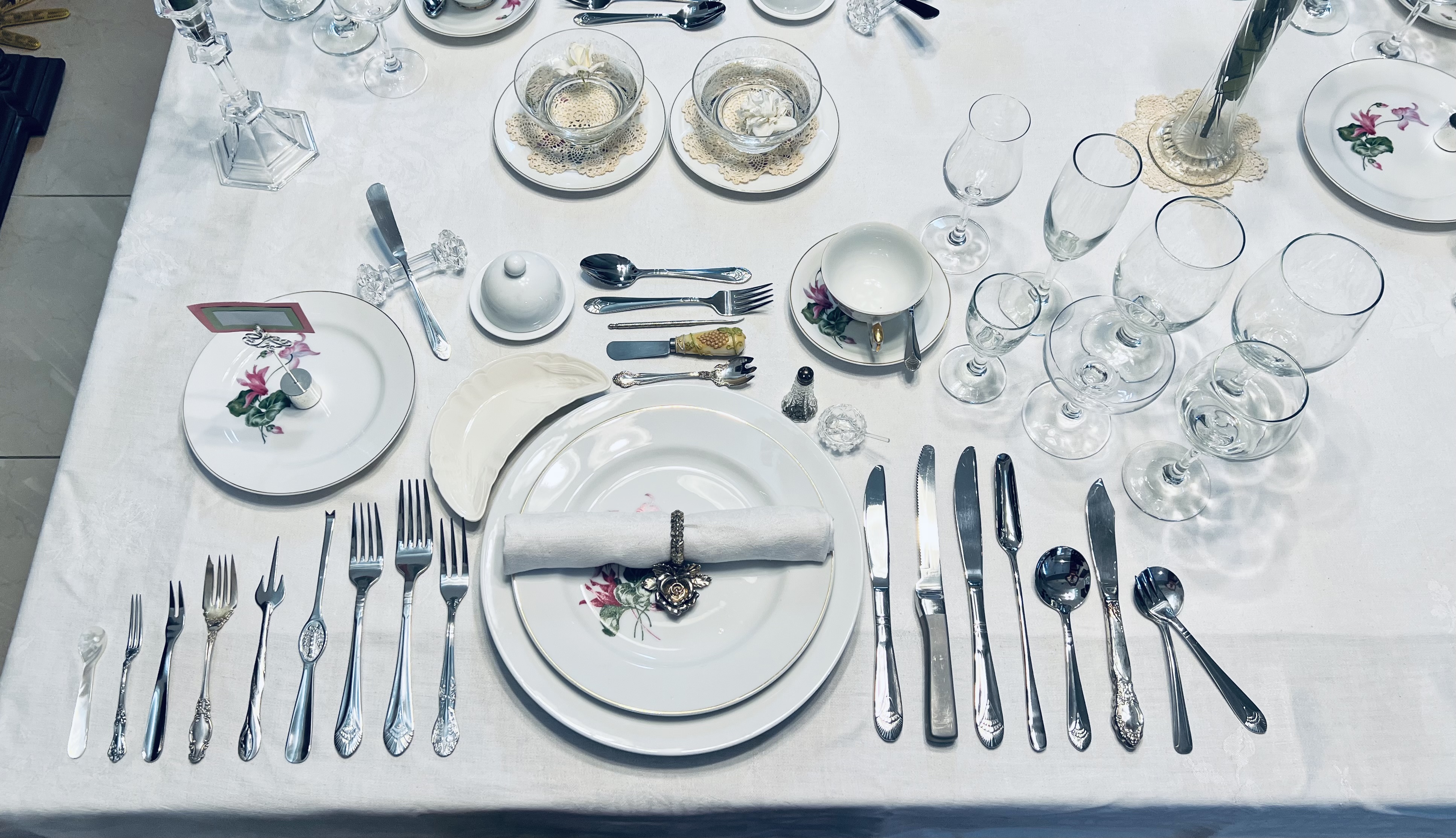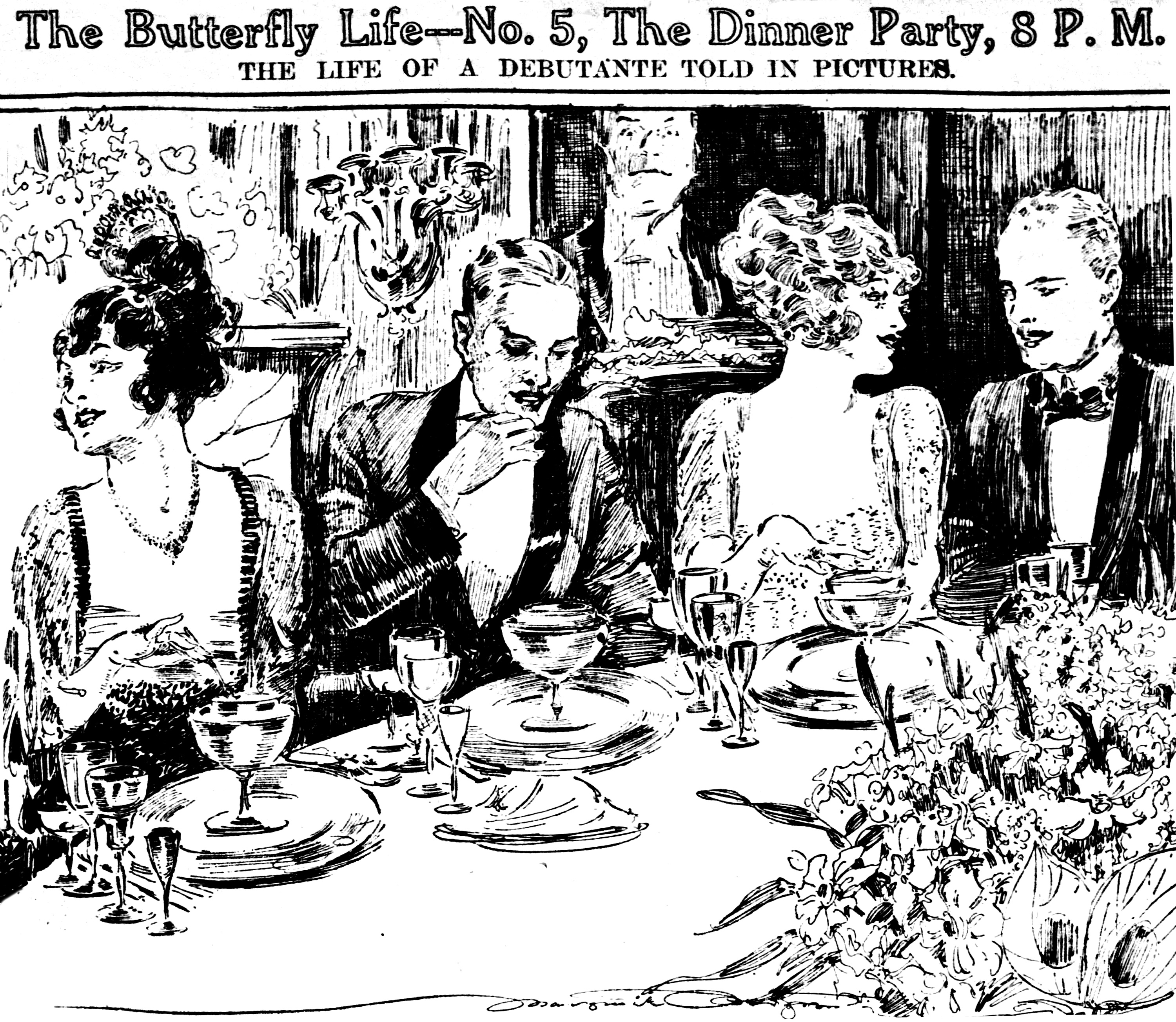Table Setting on:
[Wikipedia]
[Google]
[Amazon]
 Table setting (laying a table) or place setting refers to the way to set a table with
Table setting (laying a table) or place setting refers to the way to set a table with
 At an informal setting, fewer utensils are used and serving dishes are placed on the table. Sometimes the cup and saucer are placed on the right side of the spoon, about 30 cm or 12 inches from the edge of the table. Often, in less formal settings, the napkin should be in the wine glass. However, such objects as napkin rings are very rare in the United Kingdom, Spain, Mexico, or Italy.
At an informal setting, fewer utensils are used and serving dishes are placed on the table. Sometimes the cup and saucer are placed on the right side of the spoon, about 30 cm or 12 inches from the edge of the table. Often, in less formal settings, the napkin should be in the wine glass. However, such objects as napkin rings are very rare in the United Kingdom, Spain, Mexico, or Italy.
 Utensils are placed inward about 20 cm or 8 inches from the edge of the table, with all placed either upon the same invisible baseline or upon the same invisible median line. Utensils in the outermost position are to be used first (for example, a
Utensils are placed inward about 20 cm or 8 inches from the edge of the table, with all placed either upon the same invisible baseline or upon the same invisible median line. Utensils in the outermost position are to be used first (for example, a
 The most
The most
File:Formal Place Setting.jpg , Formal place setting for 8-course dinner
File:Appetizer Course.jpg , Appetizer course
File:Soup Course New.jpg , Soup course
File:Fish Course.jpg , Fish course
File:Entrée (entry) Course.jpg , Entrée course
File:Palatte Cleanser.jpg , Palate cleanser
File:Main (releve) course.jpg , Main (relevé) course
File:Salad Course.jpg , Salad course
File:Finger Bowl Service in preparation for dessert.jpg , Fingerbowl before dessert
File:Dessert Place Setting with finger bowl moved to left.jpg , Dessert place setting before dessert
File:Dessert Course with dessert spoon and dessert fork.jpg , Dessert course
File:Coffee and Tea Service served after dessert.jpg , Coffee/tea course
File:Tea service.jpg , Tea service
 Table setting (laying a table) or place setting refers to the way to set a table with
Table setting (laying a table) or place setting refers to the way to set a table with tableware
Tableware is any dish or dishware used for setting a table, serving food, and dining. It includes cutlery, glassware, serving dishes, and other items for practical as well as decorative purposes. The quality, nature, variety and number of o ...
—such as eating utensil
A variety of eating utensils have been used by people to aid eating when dining. Most societies traditionally use bowls or dishes to contain food to be eaten, but while some use their hands to deliver this food to their mouths, others have deve ...
s and for serving and eating. The arrangement for a single diner is called a place setting. It is also the layout in which the utensils and ornaments are positioned. The practice of dictating the precise arrangement of tableware has varied across cultures and historical periods.
Place setting
Informal settings generally have fewer utensils and dishes but use a layout based on more formal settings. Utensils are arranged in the order and according to the manner in which the diner will use them. In theWest
West or Occident is one of the four cardinal directions or points of the compass. It is the opposite direction from east and is the direction in which the Sunset, Sun sets on the Earth.
Etymology
The word "west" is a Germanic languages, German ...
, fork
In cutlery or kitchenware, a fork (from la, furca 'pitchfork') is a utensil, now usually made of metal, whose long handle terminates in a head that branches into several narrow and often slightly curved tine (structural), tines with which one ...
s, plate, butter knife, and napkin
A napkin, serviette or face towelette is a square of cloth or paper tissue used at the table for wiping the mouth and fingers while eating. It is usually small and folded, sometimes in intricate designs and shapes.
Etymology and terminology
...
generally are placed to the left of the dinner plate, and knives
A knife ( : knives; from Old Norse 'knife, dirk') is a tool or weapon with a cutting edge or blade, usually attached to a handle or hilt. One of the earliest tools used by humanity, knives appeared at least 2.5 million years ago, as evidenced ...
, spoon
A spoon is a utensil consisting of a shallow bowl (also known as a head), oval or round, at the end of a handle. A type of cutlery (sometimes called flatware in the United States), especially as part of a place setting, it is used primarily f ...
s, stemware and tumblers, cups
CUPS (formerly an acronym for Common UNIX Printing System) is a modular printing system for Unix-like computer operating systems which allows a computer to act as a print server. A computer running CUPS is a host that can accept print jobs ...
, and saucer
A saucer is a type of small dishware. While in the Middle Ages a saucer was used for serving condiments and sauces, currently the term is used to denote a small plate or shallow bowl that supports a cup – usually one used to serve coffee ...
s to the right. (By contrast, formal settings in Armenia place the fork to the right of the dinner plate and informal settings in Turkey place the fork to the right of the dinner plate if not accompanied by a knife) Sauceboats and serving dishes, when used, either are placed on the table or, more formally, may be kept on a side table.
Informal
 At an informal setting, fewer utensils are used and serving dishes are placed on the table. Sometimes the cup and saucer are placed on the right side of the spoon, about 30 cm or 12 inches from the edge of the table. Often, in less formal settings, the napkin should be in the wine glass. However, such objects as napkin rings are very rare in the United Kingdom, Spain, Mexico, or Italy.
At an informal setting, fewer utensils are used and serving dishes are placed on the table. Sometimes the cup and saucer are placed on the right side of the spoon, about 30 cm or 12 inches from the edge of the table. Often, in less formal settings, the napkin should be in the wine glass. However, such objects as napkin rings are very rare in the United Kingdom, Spain, Mexico, or Italy.
Formal
 Utensils are placed inward about 20 cm or 8 inches from the edge of the table, with all placed either upon the same invisible baseline or upon the same invisible median line. Utensils in the outermost position are to be used first (for example, a
Utensils are placed inward about 20 cm or 8 inches from the edge of the table, with all placed either upon the same invisible baseline or upon the same invisible median line. Utensils in the outermost position are to be used first (for example, a soup spoon
A soup spoon is a type of spoon with a large or rounded bowl, used for consuming soup. The term can either refer to the British soup spoon or the Chinese spoon. Round bowled soup spoons were a Victorian invention. Sets of silverware made prior to ...
or a salad fork, later the dinner fork and the dinner knife). The blades of the knives are turned toward the plate. Glasses are placed an inch (2.5 cm) or so above the knives, also in the order of use: white wine, red wine, dessert wine, and water tumbler.
Formal dinner
 The most
The most formal dinner
Dinner usually refers to what is in many Western cultures the largest and most formal meal of the day, which is eaten in the evening. Historically, the largest meal used to be eaten around midday, and called dinner. Especially among the elite, ...
is served from the kitchen. When the meal is served, in addition to the central plate (a service plate or dinner plate at supper; at luncheon, a service plate or luncheon plate) at each place there are a bread roll (generally on a bread plate, sometimes in the napkin), napkin, and flatware (knives and spoons to the right of the central plate, and forks to the left). Coffee is served in Butler Service style in demitasse
A demitasse (; French: "half cup") or demi-tasse is a small cup used to serve espresso. It may also refer to the contents served in such a cup (though that usage had disappeared in France by the early 20th century).
A demitasse typically has a ...
s, and a spoon placed on the saucer to the right of each handle. Serving dishes and utensils are not placed on the table for a formal dinner. The only exception in the West to these general rules is the protocol followed at the Spanish royal court, which was also adopted by the Austrian court, in which all cutlery was placed to the right of the central plate for each diner.
At a less formal dinner, not served from the kitchen, the dessert fork and spoon can be set above the plate, fork pointing right, spoon pointing left.
Formal dining
See also
* Cutlery (US: Flatware) *Haft-Sin
Haftsin ( fa, هفتسین) is an arrangement of seven symbolic items whose names start with the letter "س" (pronounced as "seen"), the 15th letter in the Persian alphabet; "haft" (هفت) is Persian for "seven". It is traditionally displaye ...
, traditional table setting of Nowruz, the traditional Iranian spring celebration.
* List of glassware
upTypical drinkware
The list of glassware includes drinking vessels (drinkware) and tableware used to set a table for eating a meal, general glass items such as vases, and glasses used in the catering industry. It does not include laboratory glass ...
* Napkin folding
Napkin folding is a type of decorative folding done with a napkin. It can be done as art or as a hobby. Napkin folding is most commonly encountered as a table decoration in fancy restaurants. Typically, and for best results, a clean, pressed, and ...
* Silver service
Silver service (in British English) is a method of foodservice at the table, with waiter transferring food from a serving dish to the guest's plate, always from the left. It is performed by a waiter by using service forks and spoons from the dine ...
, a method of table service in the United Kingdom
* Tableware
Tableware is any dish or dishware used for setting a table, serving food, and dining. It includes cutlery, glassware, serving dishes, and other items for practical as well as decorative purposes. The quality, nature, variety and number of o ...
References
Further reading
* {{DEFAULTSORT:Table Setting Serving and dining Etiquette